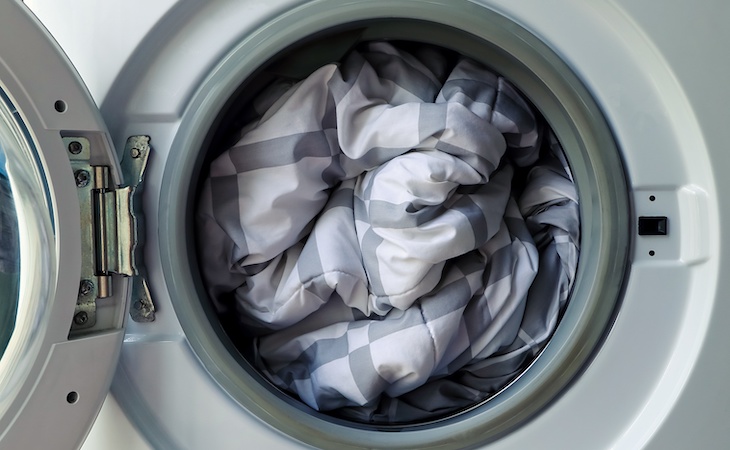Nothing feels as good as crawling into a bed with clean bedding after a long day. That means clean pillowcases, clean sheets, and even a clean comforter.
Though clean bedding sounds super simple, washing a comforter isn’t always so easy to accomplish. However, it should still be done to help ensure you get the most out of your top-of-bedding.
If you find yourself searching for “how to clean a comforter,” “how to clean a down comforter,” or “how to clean a goose down comforter,” then keep reading.
This article will explain all the ways to clean a comforter at home, including how to spot clean a comforter.

When to clean a comforter
Before we get into how to clean a comforter, let’s address when you should clean one. Nichole Mondshein, a sleep product expert at Sleepopolis, says there are a variety of factors that will dictate how often you should clean a comforter.
Think of things like the type of comforter you have, whether or not you sleep with children (or perhaps furry friends) in your bed and any allergens or before-bed snack crumbs that may sometimes make an appearance between the sheets.
“The minimum amount of times a comforter should be cleaned is about two to three times per year, but many materials like down alternatives can be cleaned more frequently without causing any harm to the material,” shares Mondshein.
What about spot cleaning a comforter? Mondshein says immediately spot treating stains may be the best option to keep your comforter looking and feeling like new.
Always read the care instructions on your particular comforter or duvet so you can treat the stain without damaging the original color or material.

How to pre-clean a comforter
Whether you have a down, goose-down, feather-down, or down alternative comforter, Mondshein shares some pre-cleaning tips when you’re getting ready to clean your comforter:
- Read and review the care instructions on your specific comforter to be sure you’re using the right methods and cleaning supplies.
- Gather the appropriate cleaning supplies based on your needs such as stain removal, fabric softening, scent refreshing, or just general cleaning products.
- Pre-treat any outstanding stains with a stain remover before placing the comforter in the washing machine.
- Place your comforter in the washing machine and begin.
Mondshein says it’s generally recommended to use cold water settings for washing your bedding.
However, every comforter is different—so it’s important to follow the care instructions to avoid accidentally shrinking, tearing, or damaging the comforter material.

The best methods for cleaning a comforter
There are a few different ways you can clean a comforter. The most popular options include using the washing machine, hand washing, and professional cleaning.
Here’s how to do each of these and when exactly they’re suitable for cleaning your comforter.
Washing machine
Mondshein says before you opt for the washing machine, always check the material of your comforter.
“Materials like silk and some down fabrics should be hand-washed,” she says. “Comforters that are made of materials like cotton, bamboo, or linen can normally be washed in a washing machine.”
Basic laundry detergents work well, but each comforter is different, explains Mondshein, which is why it’s important to read the wash and care instructions that came with your product.
This includes checking the water temperature and washing machine cycle settings. When in doubt, cold water and a delicate or gentle cycle work well.
One of the main issues you may run into when washing your comforter at home is trying to wash a larger comforter in a smaller washing machine.
If that’s the case, Mondshein recommends making a trip to the laundromat where you’ll have access to larger washing machines.
If you own a Saatva comforter, here’s a quick rundown of how to wash it:
- Machine wash on its own in cold water on a gentle cycle.
- Don’t bleach.
- Tumble dry low and remove promptly.
- Mild, organic detergents work best.
Hand washing
What about hand washing a comforter? Is all of that work really necessary? “All comforters can be hand washed if that is your preference, says Mondshein, “but specifically silk comforters and some down comforters should be hand washed.”
It may seem like a bigger undertaking, but Mondshein says the easiest way to hand wash something as large as a comforter is in the bathtub.
“Be sure that your bathtub is clean before placing your comforter in with lukewarm water and the detergent of your choice,” shares Mondshein.
She adds that using a gentle, clear detergent is recommended to wash your comforter, but this is up to preference as well.
Next, fully submerge the comforter and begin to work the soap into the fabric, kneading and squeezing any problem areas to remove stains or smells.
Professional cleaning
Although a lot of comforter cleaning can be done at home or the laundromat, sometimes, you may need to employ professional cleaners, like dry cleaners. Some materials are more delicate than others and should be cleaned with care.
“Silk and some down comforters fall into this category,” says Mondshien. “If you are hesitant about washing it on your own, sending it to be professionally cleaned is a great option.”
If you’re someone who doesn’t have a bathtub or method for hand washing, Mondshein recommends taking your comforter to a professional cleaner to play it safe.
How to wash a comforter in a washing machine
Mondshein provides a step-by-step guide on how to wash a comforter in a washing machine:
- First, check the care instructions to make sure your comforter can go in the washing machine.
- Then, make sure your comforter can fit into your washing machine.
- Add the detergent of your choice; clear and delicate detergent is normally recommended.
- Next, according to the care instructions, select the correct settings on your washing machine; cold and delicate settings are usually preferred, but each material may be different.

How to spot clean a comforter
If using a washing machine to clean your comforter isn’t an option, Mondshein offers steps on how to spot clean a comforter.
“The way that you spot clean your comforter is dependent on a few things,” shares Mondshein. Think of things like the color, the material, the stain or the problem area, and if you’re planning on fully washing the comforter after applying a spot treatment.
“If you are just cleaning a specific spot on your comforter, you should find a cleaning solution that will work for the material of your comforter,” says Mondshein. “Some options could include Woolite, other gentle fabric cleaners, or a mixture of baking soda and water.”
Mondshein says you should then use your cleaning solution to blot and scrub the stain to loosen and remove it.
“Some stains may be more difficult to remove than others—and for more difficult-to-clean stains, it is important to apply the cleaning solution as soon as possible after the accident happens,” instructs Mondshein.
After you’ve removed the stain, you can either opt to wash your entire comforter by hand or in the washing machine, says Mondsehin. You can also choose to rinse the area with cold, clean water and allow it to air dry.

How to dry a comforter
After you’ve washed your comforter (whether in the washing machine or by hand), it’s time to dry it. What’s the best way to do that?
“Some comforters can be dried in the dryer and others may be better air-dried,” says Mondshein. “Materials like silk should not go in the dryer, so air drying a silk comforter would be in its best interest—but materials like cotton are normally OK to be dried on delicate settings.”
As always, Mondshein reminds you to check your comforter’s wash instructions before attempting to dry it in the dryer.
“If you need to air dry your comforter, it may be best to use a clothing line or rack to spread the fabric out as much as possible so it can dry evenly,” says Mondshein.
If you’re planning to dry your comforter in the dryer, Mondshein suggests using low heat settings and selecting a setting that works best for large items such as “bulky” or “bulky items and sheets.”
If you’re worried about the comforter filling bunching up or the comforter drying unevenly or overheating, Mondshein says you can use tennis balls. “This may also help the comforter dry faster and maintain its fluffiness,” she explains.
How to maintain a clean comforter
Once your comforter is washed and dried, you’ll want to maintain a clean comforter for as long as possible. You can do this by setting a regular cleaning schedule.
“The best regular wash schedule for your comforter will be dependent on the material that it is made of,” says Mondshein. “However, when you learn the material and can set a wash schedule, it is important to stick to it to keep your comforter generally clean to avoid the build-up of skin cells, dust, mites, and other possible allergens, smells, and stains.”
It’s important to spot treat stains and spills immediately after they happen to reduce permanent stains as well.
Additionally, “If you switch your comforter out a few times a year, you should be sure that you are storing extra ones in a clean and dry space where they will not come in contact with allergens or water that could cause mildew,” says Mondshein.
Normally, a closed lid container in a dry space, or a drawer will work just fine.
FAQs
Can I wash my comforter in the washing machine?
Always check the material of your comforter before washing it in the washing machine. Materials like silk and some down fabrics should be hand washed, while materials like cotton, bamboo, or linen can normally be washed in a washing machine.
How do you deep clean a comforter?
If you want to deep clean your comforter, consider washing it in your washing machine, giving it a good soak in the bathtub, or taking it to the dry cleaner for a professional cleaning.
How do you clean a comforter that’s too big for the washer?
If a comforter is too big to clean in your washing machine at home, it’s best to take it to a laundromat so you have access to a larger washing machine.
Is it better to dry clean or wash a comforter?
When it comes to dry cleaning a comforter or washing it in a washing machine, one isn’t better than the other. It mostly comes down to whether or not your comforter material is safe to wash in the washing machine or needs to be dry cleaned. More delicate fabrics may need to be professionally cleaned at the dry cleaners.
How much does it cost to dry clean a comforter?
“Having your comforter dry cleaned can cost anywhere from $20 to $60 on average,” says Mondshein. “The price will vary depending on where you go as well as the size and material of your comforter.”
Find the best comforter for you at Saatva
After years of cleaning, it may finally be time to upgrade your comforter. You’re in luck: Saatva offers a range of down alternative comforters to suit every sleep style. So, if your comforter is past its prime and you’re ready to replace it, you can find an option that works for you here.
Check out a few popular selections, like the

Plush and breathable all-season comforter/duvet insert
,

A lighter version of our comforter/duvet insert for cooler sleep
, and

An ultra-warm version of our comforter/duvet insert for your coziest sleep
. We also offer a variety of duvet covers to protect these comforters and add a splash of style to your bedroom.




